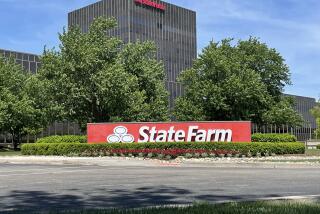HomeFed Posts Quarterly Loss of $176 Million : Finance: The bank’s parent company says its problem assets have increased by $535 million. It may be unable to meet tougher capital rules.
- Share via
SAN DIEGO — Reeling from the rapid decline of California’s commercial real estate markets, the parent of HomeFed Bank on Thursday reported a $176-million fourth-quarter loss and said it expects to be short of one of the minimum regulatory capital requirements in the coming months.
HomeFed also announced Thursday that its problem assets had ballooned by $535 million in just three months, to $1.2 billion, or 6.4% of its $18.3 billion in total assets. The thrift also said it was suspending its quarterly dividend of 5 cents a share.
Taken together, the developments leave San Diego-based HomeFed badly weakened and prompt some analysts to question its chances of survival. The high percentage of bad loans--far above the 3% benchmark for healthy thrifts--is doubly damaging in that it reduces an S&L;’s income and necessitates loan write-offs later.
“I was expecting the worst, and HomeFed delivered,” said Campbell Chaney, an S&L; analyst with the Sutro & Co. investment firm in San Francisco.
“(HomeFed) is severely weakened, yes. Is it terminal? It’s a question mark. It could go either way at this point, all depending on how the economy goes--specifically, how the real estate market acts in the coming six months.”
There could be more bad news ahead. Audits by the Office of Thrift Supervision and the Federal Deposit Insurance Corp. are only “in the initial stages” at HomeFed and will not be concluded until the end of March, HomeFed President Robert F. Adelizzi said in an interview. In the past, regulatory audits often have resulted in aggressive writedowns of some S&L; loans.
“I can’t predict whether the worst is behind us,” Adelizzi said. “We believe our (loan-loss) provisions are adequate and that we have done the best we can evaluating our loans.”
As recently as one year ago, HomeFed was viewed as one of the thrift industry’s stalwarts and among the S&Ls; most likely to survive the severe shakeout that has befallen the industry. But HomeFed has been hurt by its deep involvement in commercial real estate lending and development. Only 60% of its loans are in single-family mortgages, compared to 90% at some still-healthy thrifts. The balance are in apartment and commercial real estate projects.
That commercial real estate loan portfolio is responsible for a disproportionate 95% share of HomeFed’s problem loans, Adelizzi said.
And because of its real estate development activities, HomeFed expects to run afoul of new capital requirements that take effect July 1. The new federal regulations will significantly change the rules governing “risk-based” capital that HomeFed and other S&Ls; must keep in reserve for real estate development projects. While in conformity with all three current regulatory capital levels, HomeFed said Thursday that it does not expect to meet the new requirements.
Adelizzi said the capital shortfall will force HomeFed to file a plan with regulators outlining how it hopes to return to conformity. Regulators typically impose a broad range of operating restrictions on S&Ls; in violation. Adelizzi did not discuss details of what the plan might entail for HomeFed but said he expects to reduce assets by $2 billion by the end of 1991. The fourth-quarter loss, which compares to a $33-million profit a year earlier, was caused largely by a loan loss provision of $250 million. For all of 1990, HomeFed lost $248 million, compared to a $116-million profit in 1989.
HomeFed had announced in November that its loan portfolio had soured to the point that it expected nonperforming assets to reach at least $1 billion by Dec. 31. At the time, Adelizzi blamed “across-the-board loan problems, including delinquent single-family mortgages.”
More to Read
Inside the business of entertainment
The Wide Shot brings you news, analysis and insights on everything from streaming wars to production — and what it all means for the future.
You may occasionally receive promotional content from the Los Angeles Times.










